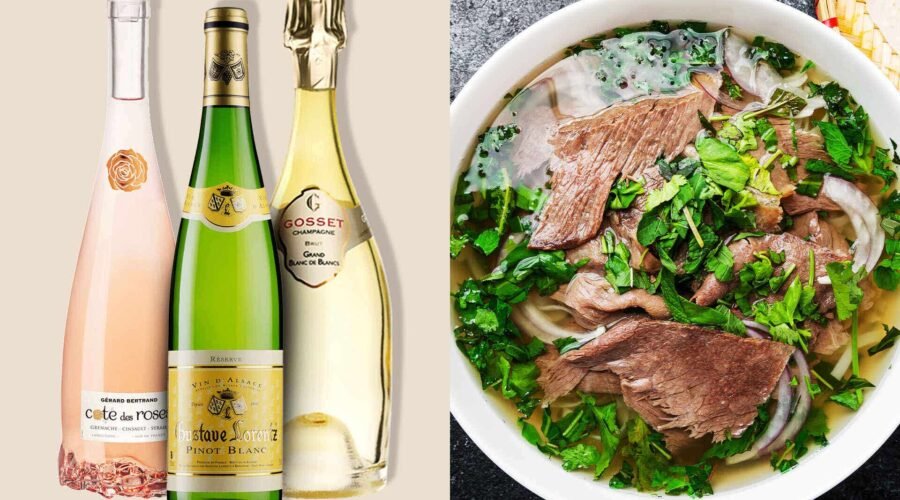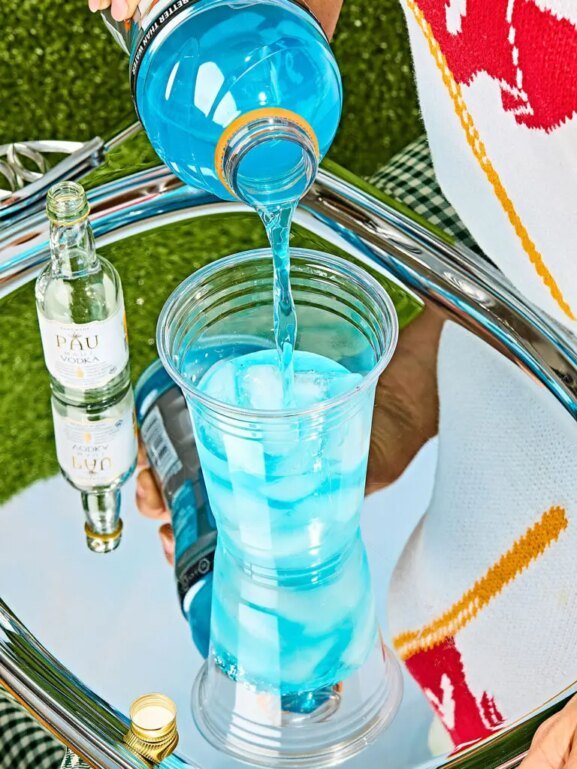Ratings: How to Pair Classic Vietnamese Foods with Wine
Vietnamese food is often an artful symmetry between five fundamental flavors: salt, sweet, sour, bitter and spice. Each dish typically has a vibrant blend of bright herbs and fresh vegetables, arranged in colorful presentations. And since Vietnamese cuisine aims to balance flavors and leans less spicy than other Asian fare, it goes beautifully with most styles of wine.
And like many other Asian cuisines, Vietnamese food is typically served communal style—meaning opening multiple bottles for the table is completely acceptable. “Vietnamese dining is very celebratory and inviting,” describes Duyen Ha, founder of Bondle Wines, an online wine retailer specializing in magnums of French natural wines.
So, what should you pair your favorite Vietnamese dishes with? When it comes to red wine pairings, our experts gravitate toward light-bodied, fruity wines, like Beaujolais. These wines can complement and enhance nuances in Vietnamese dishes, like herbal flavor, instead of overpowering them. In contrast, the tannic notes of some heavier red wines can clash with many common Vietnamese ingredients, like fish sauce. That said, there are some fattier dishes, like bò lúc lắc (a dish of seared cubed beef with a savory glaze, in English known as shaking beef) that can stand up well to a bolder wine, like Cabernet Sauvignon.
White, rosé and orange wines tend to be much easier to pair with Vietnamese foods. Stephen Mallory, beverage director of Kingfisher restaurant in San Diego, chooses wines with high acidity to pair with umami-forward foods and opts for light-bodied, floral varieties for herbaceous meal pairings. Creamier wines round out foods that have a lot of spice, he adds.
Ha adds that everything must be served at the right temperature and time. When serving sparkling or white wines alongside the meal, Ha likes to pop the bottle in the freezer for 10 to 15 minutes before opening them. For orange and red wines, she recommends decanting them for about two hours prior to serving to allow their nuances to shine.
We asked wine industry pros to recommend a style of wine that matches the flavor profiles of these popular Vietnamese dishes; the Wine Enthusiast team matched their suggestions with highly-rated bottles we love.
Interested in crafting your own traditional Vietnamese menu with wine pairings? Look no further.
Vietnamese Food and Wine Pairings
The Best Wine for Bún Chả (Grilled Pork Meatballs with Vermicelli)
These grilled pork meatballs are small and flat, allowing for a deep char on the outside. They are served with vermicelli noodles, nước chấm (a Vietnamese dipping sauce made of fish sauce, lime juice, sugar and a hint of red chili) and fresh herbs. The dish is savory, but still very light. Ha recommends pairing bún chả with a red wine, like Cabernet Franc. The red fruit of the wine complements the smoky pork, while the tannins stand up to the texture of the pork and the acidity accentuates the fresh herbs.

The Best Wine for Bánh Xèo (Pork Belly and Shrimp Crepe)
The “xèo” part of this dish’s name is taken from the sizzling sound made when crepe batter—made from rice flour, turmeric and coconut cream—hits the pan. Known as Vietnamese pancakes or Vietnamese crepes, bánh xèo is traditionally stuffed with pork belly, shrimp, mung beans and bean sprouts. It’s served one of two ways: In central Vietnam, the crepe is broken into smaller pieces and wrapped in rice paper. In southern Vietnam, however, the crepe is wrapped in leafy lettuce. Despite the heavy filling, the crepe stays light and crunchy. Wynn Austin, a Vietnamese-born food entrepreneur and founder of Wynn’s Kitchen, a line of Asian food products, recommends a dry, floral rosé to complement the delicate nature of the dish while balancing the fattiness from the pork belly.

The Best Wine for Chả Cá Thăng Long (Vietnamese Turmeric Fish with Dill)
One of Hanoi’s most popular dishes, chả cá thăng long is a grilled white fish rubbed with turmeric, fish sauce, ginger and garlic. Served on a bed of vermicelli noodles, the fish is adorned with dill, spring onion and roasted peanuts along with mint and coriander. A side of fermented shrimp paste (xiā jiàng) adds an earthy, umami note to the dish. According to Ha, the complex layers of umami go well with the nuanced flavors of non-vintage Champagne, which highlights the freshness of the fish and adds balance to the more fermented notes.

The Best Wine for Cá Kho Tô (Caramelized and Braised Catfish)
Cá kho tô is a rich dish with sweet and salty flavors and a sticky sauce. For balance, it’s traditionally served with sliced cucumbers, boiled vegetables and lots of fluffy white rice. Alongside it, Ha loves sipping an orange wine with a hint of sourness and earthy nuttiness to round out the flavors on the palate.

The Best Wine for Bò Lúc Lắc (Shaking Beef)
Named after the dish’s style of preparation, which involves shaking cubes of beef around a ripping hot pan, bò lúc lắc is a mainstay of Vietnamese cuisine. Made with fatty, seared ribeye, the meat is presented with tomato rice (rice mixed with garlic, tomato paste and fish sauce). It’s one of Austin’s favorite recipes, and she likes to pair it with a bold Cabernet Sauvignon. The fattiness of the beef stands up to the persistent tannins in the wine, making them a good match for each other.

The Best Wine for Miến Xào Cua (Crab Glass Noodles)
Fresh crab meat and delicate glass noodles come together with crunchy vegetables and refreshing aromatics in this popular stir fry option. It’s often served as part of a banquet meal for special occasions. For a wine that stands up to the high acid of the lime-fish sauce dressing, Mallory recommends a wine with a creamy texture, like an oak-aged Chardonnay or a Viognier. The sweetness of the crab meat is benefited by a crisp glass of Sauvignon Blanc.

The Best Wine for Phở Bò (Beef and Rice Noodle Soup)
Arguably Vietnam’s most famous dish, phở’s features a warming broth ideal for both chilly days and blistering-hot summers. In Hanoi, it is often eaten for breakfast, but the versatility of the dish makes it a go-to at any time of day—and an ideal partner for either red or white wine. Austin prefers a crisp white wine, like an Alsace Pinot Blanc, to refresh the palate from the salty and earthy flavors of the soup. If opting for a red, she recommends staying away from tannic offerings, as those can clash to produce a metallic taste. Instead, choose a Beaujolais for a slightly herbaceous finish.

Gustave Lorentz 2021 Réserve Pinot Blanc (Alsace)
While juicy apple aromas are present, this wine has a deliciously flinty nose that’s an unexpected delight from a Pinot Blanc. The palate also walks that line between soft orchard fruit, lime zest and flint, held together with tight acidity. Light bodied and palate cleansing, the wine packs a lot of salinity into a long finish. Complex without being overbearing, this wine would do well with a cheeseboard or salad course. 92 Points—Layla Schlack
$22
Wine.com
Why You Should Trust Us
All products featured here are independently selected by our team, which is comprised of experienced writers and wine tasters and overseen by editorial professionals at Wine Enthusiast headquarters. All ratings and reviews are performed blind in a controlled setting and reflect the parameters of our 100-point scale. Wine Enthusiast does not accept payment to conduct any product review, though we may earn a commission on purchases made through links on this site. Prices were accurate at the time of publication.


